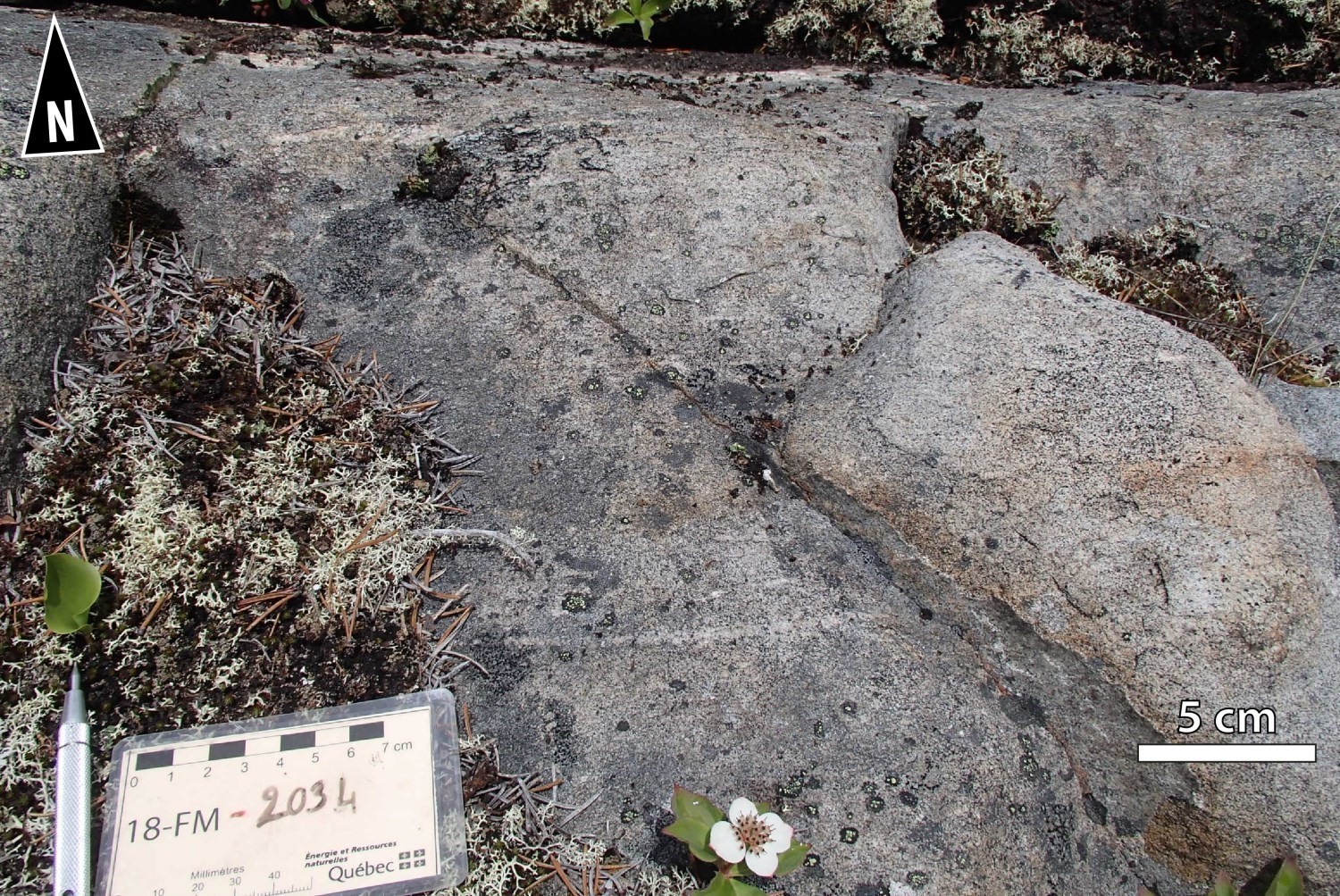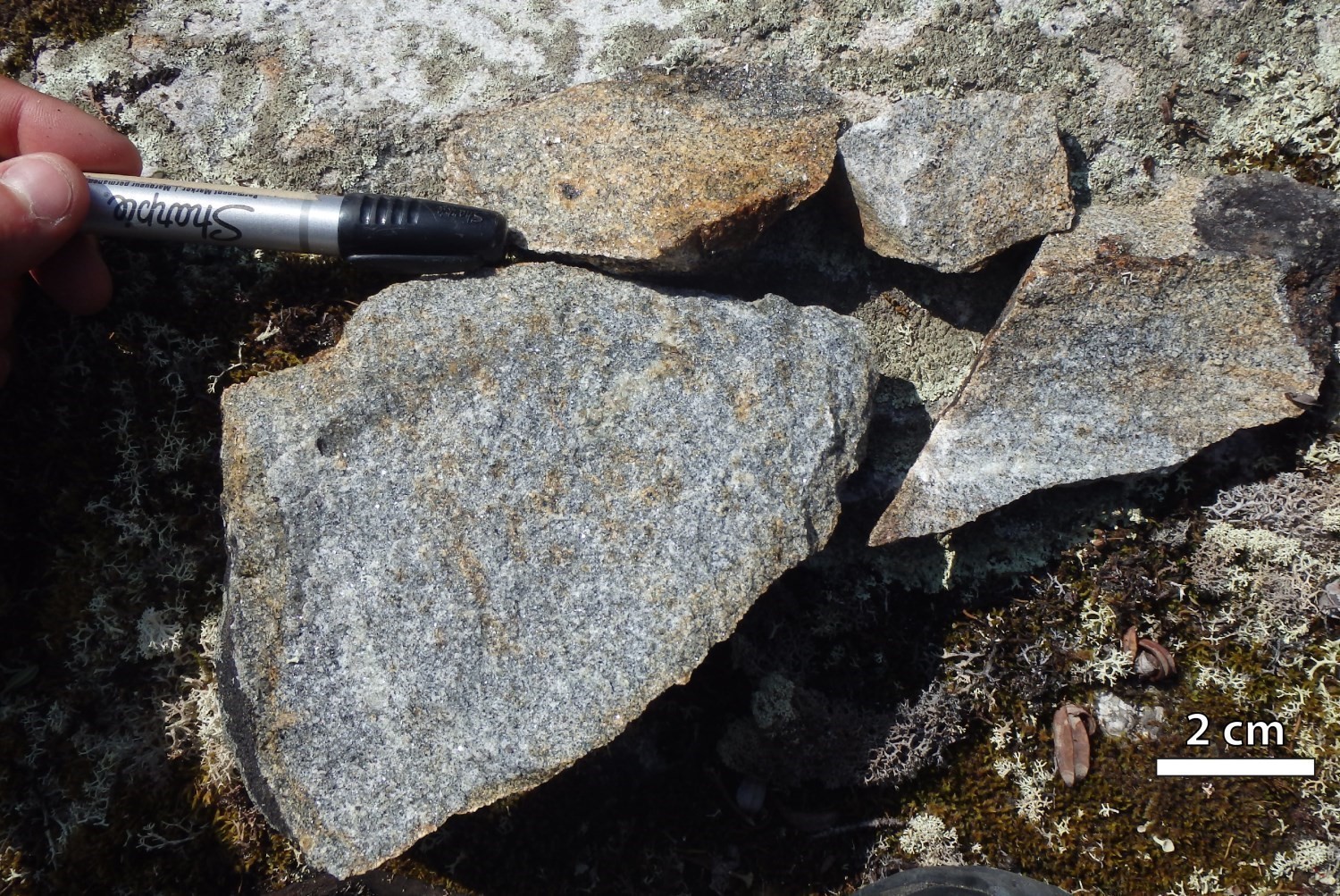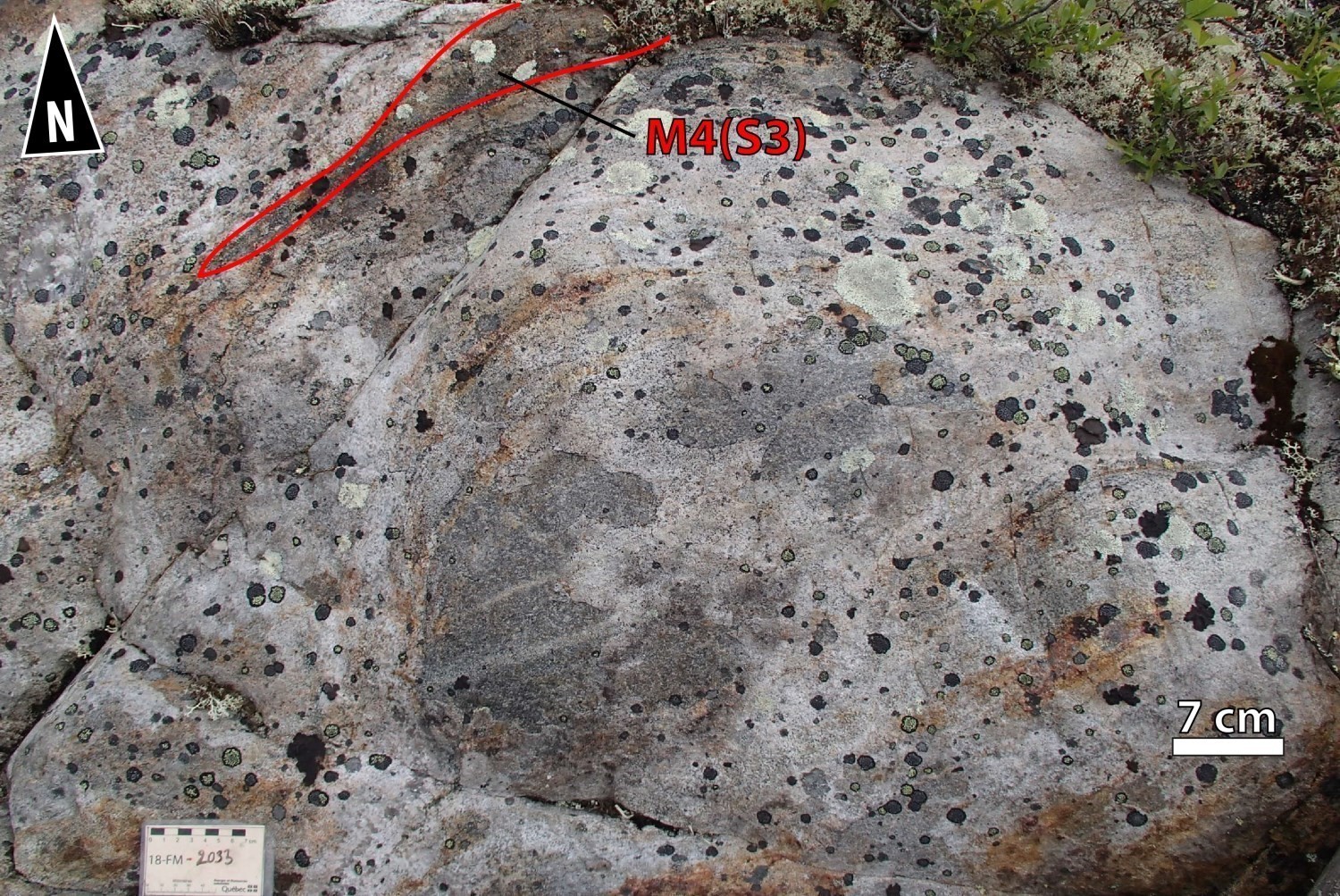
Last modified:
DISCLAIMER: This English version is translated from the original French. In case of any discrepancy, the French version shall prevail.
| Author: | Beauchamp, 2020 |
| Age: | Neoarchean |
| Stratotype: | None |
| Type area: | Cadieux Lake area (NTS sheet 33A02), between Sorbier and Mabille lakes |
| Geological province: | Superior Province |
| Geological subdivision: | Opinaca Subprovince |
| Lithology: | Intrusive, volcanic and metamorphic rocks |
| Category: | Lithodemic |
| Rank: | Complex |
| Status: | Formal |
| Use: | Active |
None
Background
Hocq (1985) identified mafic rock klippes (gabbro, hornblendite) and ultramafic horizons in the Mabille and Maville lakes area. At that time, these mafic-ultramafic horizons were part of the Base Gneissic Complex, a much larger unit interpreted as bedrock. The Mabille Complex was introduced following the Ministère’s 2018 mapping work in the Cadieux Lake area (Beauchamp, 2020). Inside the Opinaca metasedimentary basin, the Mabille Complex consists of mostly tonalitic rocks and supracrustal rock klippes.
Description
The Mabille Complex has been divided into five informal units by Beauchamp (2020): 1) a unit of foliated, granoblastic biotite ± magnetite tonalite and quartz diorite (nAmbi1); 2) a unit of foliated biotite-magnetite granite and granodiorite (nAmbi2); 3) a unit of foliated hornblende-magnetite gabbro and diorite (nAmbi3); 4) a unit of foliated peridotite showing a cumulate texture (nAmbi4); and 5) a unit of amphibolitized basalt, garnet amphibolite and tuff (nAmbi5).
Mabille Complex 1 (nAmbi1): Foliated and Granoblastic Biotite ± Magnetite Tonalite and Quartz Diorite
White in altered surface and light grey in fresh exposure, tonalite is usually fine to medium grained. Granoblastic, it ranges from moderately to highly foliated. Folding is marked by the alignment of biotite in flattening planes. In thin sections, rocks show polygonal and interlobed textures. Quartz (20-35%) forms sutured polycrystalline zones having undulatory extinction. Fine-grained microcline is usually interstitial and represents <5% of the rock. Fine bands more potassic are aligned in the same direction as foliation. These thin bands contain up to 12% microcline. Plagioclase is moderately to strongly damouritized. Biotite (<10%) is weakly to fully chloritized. Epidote clusters replace biotite. Accessory minerals observed in thin sections are epidote (allanite and pistachite), muscovite, apatite, zircon, monazite, calcite, pyrite (<2%) and hematite.
Geochemical data (Beauchamp, 2020) of the Cadieux Lake project indicate that homogeneous tonalites of the Mabille Complex are magnesian granitoids, generally calcic (Frost et al., 2001) and type I peraluminous (Maniar and Piccoli, 1989). Normalized to CI chondrite (Palme and O’Neill, 2004), these rocks have a pattern enriched in light rare earths. They exhibit negative anomalies in Nb, P, Sm, and Ti, as well as positive anomalies in Ta, La-Ce, Nd, and Zr-Hf compared to the primitive mantle (McDonough and Sun, 1995).
Mabille Complex 2 (nAmbi2): Foliated Biotite-Magnetite Granite and Granodiorite
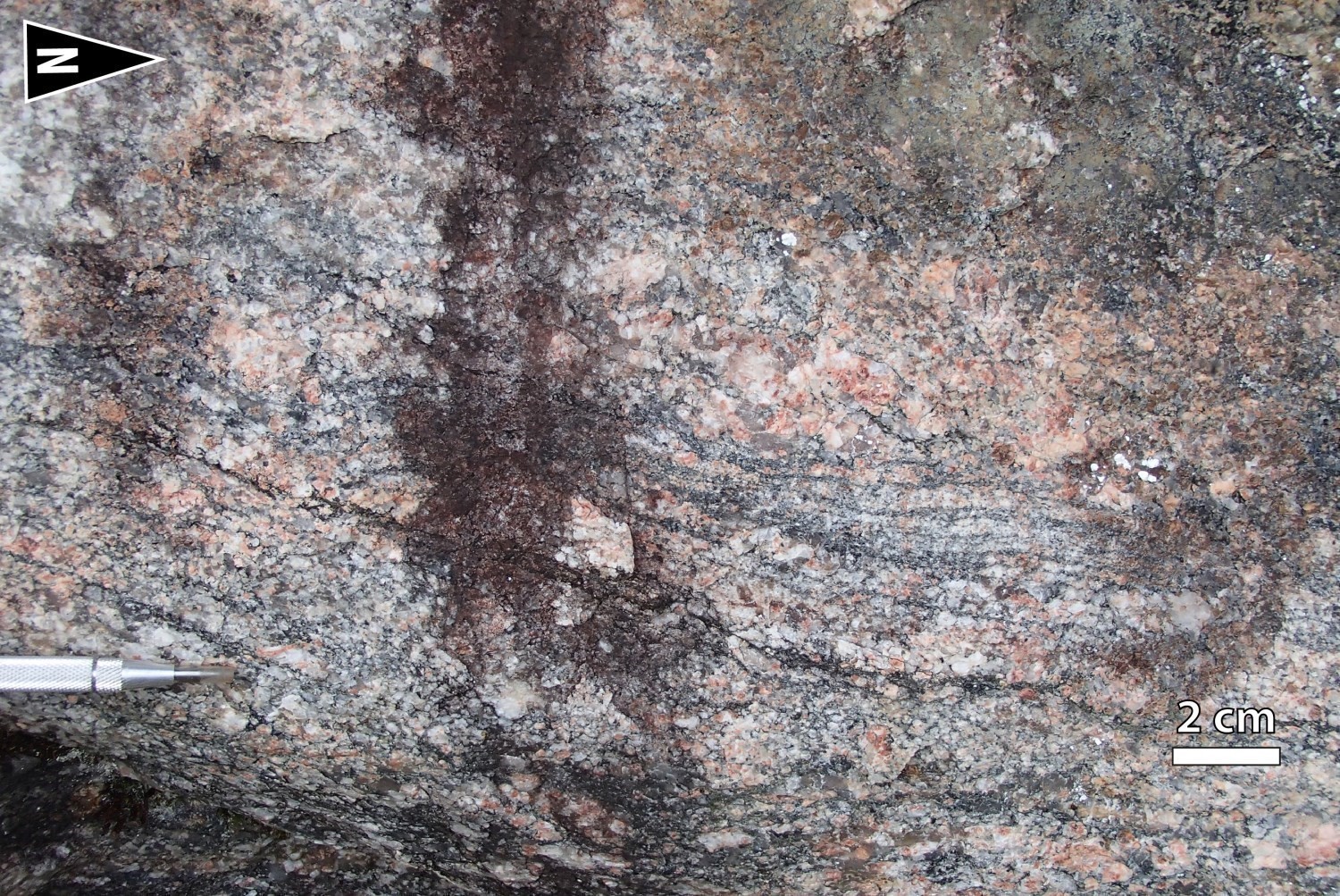 Few outcrops are present on magnetic highs attributed to unit nAmbi2. The following description is based solely on five observation sites (outcrops 18-PG-4124, 18-MP-5065, 18-LP-6062, 18-LP-6172 and 18-LP-6173). Several geological zones were interpolated and interpreted using the aeromagnetic map. Unit nAmbi2 varies in composition from granitic to granodioritic. The rock is heterogeneous and pinkish-white in altered patina and fresh exposure. It seems to have assimilated a variety of materials: tonalite, quartz diorite and paragneiss restites, as well as biotite-magnetite schlierens. These remnants of digested enclaves give a banded and marbled appearance to the rock. The distribution of ferromagnesian minerals is irregular. Generally, more biotite (3%) is observed than hornblende (trace-1%). Millimetric to centimetric magnetite, chlorite and epidote are also present in minor proportions.
Few outcrops are present on magnetic highs attributed to unit nAmbi2. The following description is based solely on five observation sites (outcrops 18-PG-4124, 18-MP-5065, 18-LP-6062, 18-LP-6172 and 18-LP-6173). Several geological zones were interpolated and interpreted using the aeromagnetic map. Unit nAmbi2 varies in composition from granitic to granodioritic. The rock is heterogeneous and pinkish-white in altered patina and fresh exposure. It seems to have assimilated a variety of materials: tonalite, quartz diorite and paragneiss restites, as well as biotite-magnetite schlierens. These remnants of digested enclaves give a banded and marbled appearance to the rock. The distribution of ferromagnesian minerals is irregular. Generally, more biotite (3%) is observed than hornblende (trace-1%). Millimetric to centimetric magnetite, chlorite and epidote are also present in minor proportions.
Mabille Complex 3 (nAmbi3): Foliated Hornblende-Magnetite Gabbro and Diorite
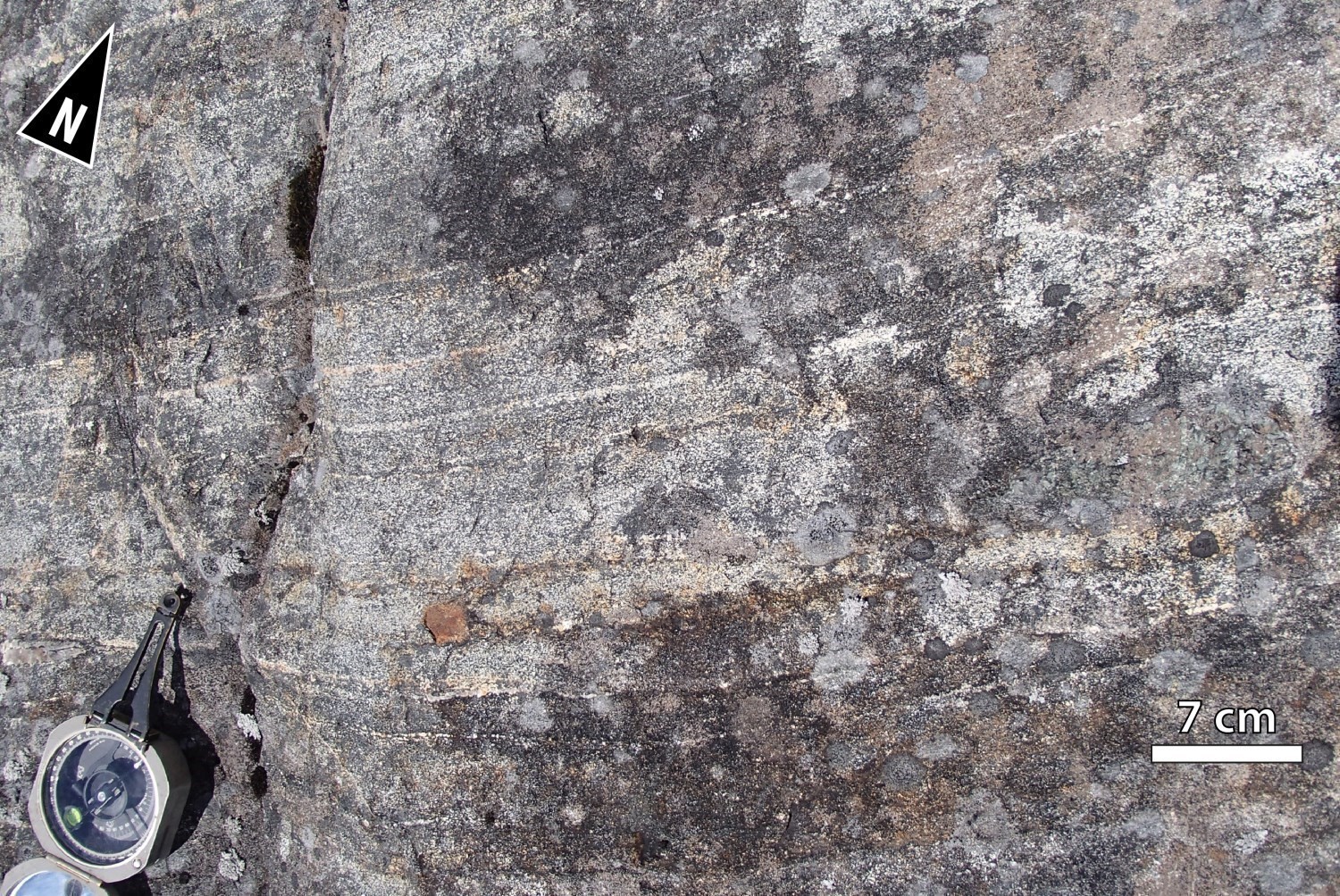 The number of outcrops observed on magnetic highs attributed to unit nAmbi3 is very limited. The following description is based on three observation sites (outcrops 18-FM-2042, 18-LP-6061 and 18-AH-8066) and compilation outcrops described by Hocq (1985). Unit nAmbi3 consists of foliated, amphibolitized and granoblastic gabbro and diorite containing hornblende ± magnetite ± biotite. Actinolite, sphene and epidote are also observed in lesser amounts. The presence of thin layers of leucosome (<5%) suggests a low degree of in situ partial melting. Banding is created by compositional variations. The content of ferromagnesian minerals allows for the differentiation between mesocratic and melanocratic bands in the rock.
The number of outcrops observed on magnetic highs attributed to unit nAmbi3 is very limited. The following description is based on three observation sites (outcrops 18-FM-2042, 18-LP-6061 and 18-AH-8066) and compilation outcrops described by Hocq (1985). Unit nAmbi3 consists of foliated, amphibolitized and granoblastic gabbro and diorite containing hornblende ± magnetite ± biotite. Actinolite, sphene and epidote are also observed in lesser amounts. The presence of thin layers of leucosome (<5%) suggests a low degree of in situ partial melting. Banding is created by compositional variations. The content of ferromagnesian minerals allows for the differentiation between mesocratic and melanocratic bands in the rock.
Mabille Complex 4 (nAmbi4): Foliated Cumulate Peridotite
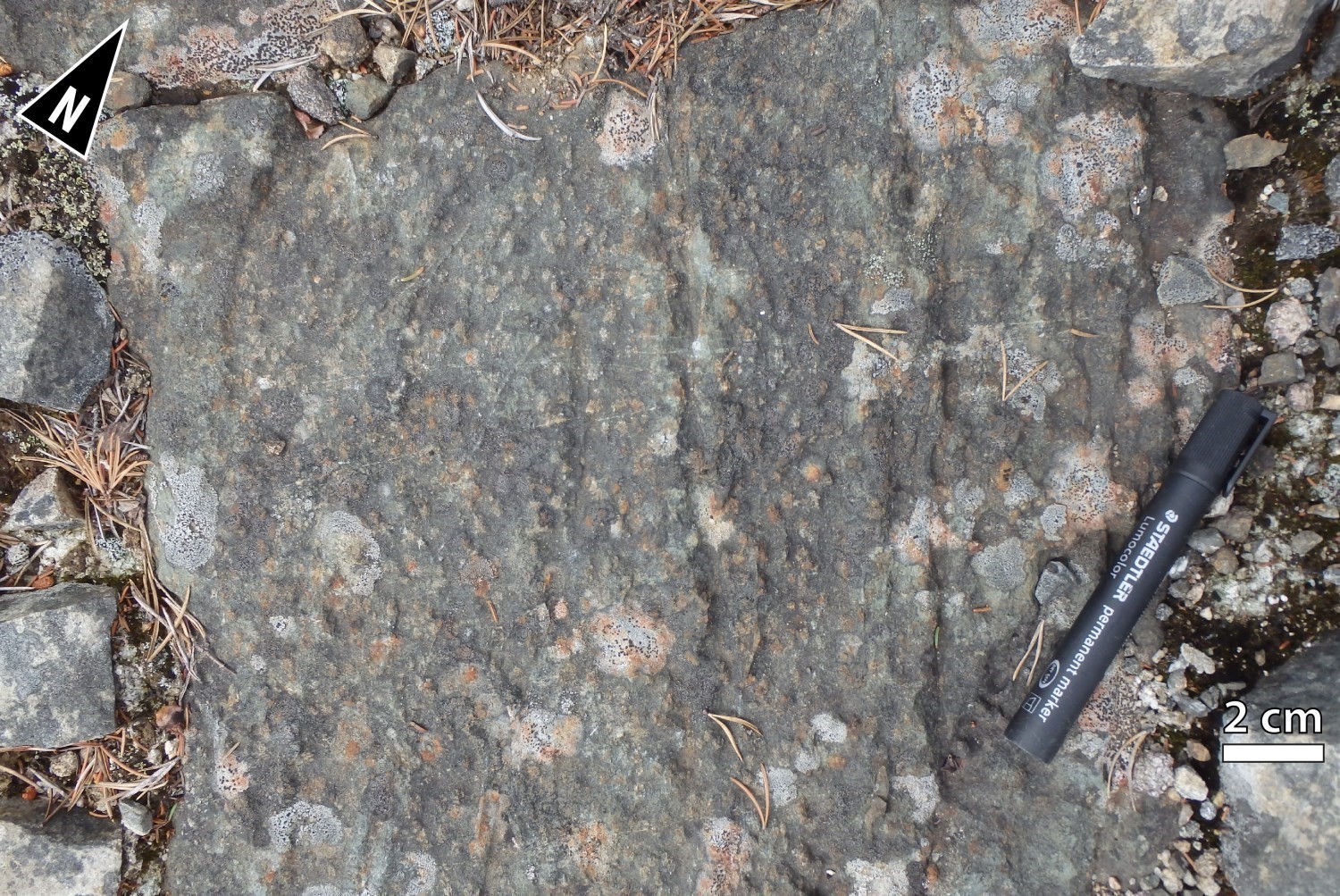 Unit nAmbi4 consists of ultramafic intrusions characterized by high magnetic susceptibility. These bodies are elongated, lenticular and spatially associated with amphibolitized basalt (unit nAmbi5). Ultramafic rock outcrops are usually in positive relief and characterized by a brownish to greenish-black patina. The most documented facies is foliated peridotite exhibiting a cumulate texture that shows black nodules (protuberances) or rounded millimetric hollows on the surface. Olive cumulates are completely replaced by serpentine and magnetite. In thin section, rocks of the nAmbi4 unit are mostly composed of acicular amphibole of the actinolite-tremolite series and pyroxene remains. Antophyllite, if present, forms colourless rods that cut the main foliation. Rocks enriched in K2O contain phlogopite flakes. Serpentine and magnetite veinlets cut the rock in several directions. Traces of magnesium chlorite and spinel (green and brown) are present. Less common, pyroxenite layers are distinguished by their apple-green alteration patina. These rocks contain actinolite, pyroxene and phlogopite.
Unit nAmbi4 consists of ultramafic intrusions characterized by high magnetic susceptibility. These bodies are elongated, lenticular and spatially associated with amphibolitized basalt (unit nAmbi5). Ultramafic rock outcrops are usually in positive relief and characterized by a brownish to greenish-black patina. The most documented facies is foliated peridotite exhibiting a cumulate texture that shows black nodules (protuberances) or rounded millimetric hollows on the surface. Olive cumulates are completely replaced by serpentine and magnetite. In thin section, rocks of the nAmbi4 unit are mostly composed of acicular amphibole of the actinolite-tremolite series and pyroxene remains. Antophyllite, if present, forms colourless rods that cut the main foliation. Rocks enriched in K2O contain phlogopite flakes. Serpentine and magnetite veinlets cut the rock in several directions. Traces of magnesium chlorite and spinel (green and brown) are present. Less common, pyroxenite layers are distinguished by their apple-green alteration patina. These rocks contain actinolite, pyroxene and phlogopite.Based on geochemical data (Beauchamp, 2020), the normative composition of peridotite is defined as lherzolite with a MgO content ranging from 62.95% to 71.34%. It shows flat rare earth profiles and a small negative P anomaly on the spider diagram.
Mabille Complex 5 (nAmbi5): Amphibolitized Basalt, Garnet Amphibolite and Tuff
Unit nAmbi5 consists mainly of amphibolitized mafic volcanics of basaltic composition. Rocks feature pillowed (outcrops 18-PG-4126 and 18-WM-3071) or massive textures. Remains of saussuritized cores and amphibolitized pillow edges are apparent. Garnet amphibolite bands, which could correspond to silicate facies iron formation, and thin tuff layers are inserted in the basaltic sequence. The alteration affects this unit in a stratiform manner as silicified and sericitized bands or calcosilicate alteration (diopside, clinozoisite and chlorite). In thin section, basalt and amphibolite contain mostly hornblende, highly damouritized plagioclase and traces of epidote, chlorite and muscovite. Garnet, if present, forms rounded poikiloblasts containing quartz and hornblende inclusions. Garnet fractures are chloritized. The triple junction between minerals indicates strong recrystallization (granoblastic texture). Unit nAmbi5 is intruded by massive granite and cut by quartz-diopside-epidote-calcite-pyrite veins and veinlets.
From a geochemical point of view (Beauchamp, 2020), mafic rocks of the Mabille Complex are subalkaline basalt and tholeiitic andesitic basalt (Winchester and Floyd, 1977; Pearce, 1996; Ross and Bédard, 2009) similar to N-MORB. These rocks, thought to have been formed in an island arc-like setting (Pearce and Norry, 1979; Meschede, 1986), are believed to have originated from a source that has undergone minor crustal contamination (Pearce, 2008). Unit nAmbi5 is characterized by flat rare earth profiles and the presence of small negative Ta and P anomalies on spider diagrams.
Thickness and Distribution
The Mabille Complex appears as a wide E-W strip that crosses sheet 33A02 over a distance of >40 km in the Mabille and Sorbier lakes area. The maximum width of this complex is 4.5 km in the central portion of the sheet. It gradually wedges out eastward and westward in sheets 33A01 and 33A03, respectively.
Dating
The isotopic dating of a homogeneous biotite-magnetite tonalite (outcrop 18-FM-2034) yielded a Neoarchean age (Davis, 2019).
| Unit | Sample Number | Isotopic System | Mineral | Crystallization Age (Ma) | (+) | (-) | Reference(s) |
| nAmib1 | 2018-FM-2034A | U-Pb | Zircon | 2705 | 4 | 4 | Davis, 2019 |
Stratigraphic Relationship(s)
The Mabille Complex outcrops within metasedimentary rocks of the Laguiche Complex, which has an estimated maximum sedimentation age of 2694 ±10 Ma in the Cadieux Lake area (U-Pb on detrital zircons; Davis, personal communication, 2019). The Mabille Complex tonalite, dated 2705 ±4 Ma (Davis, personal communication, 2019), intrudes into metasedimentary rocks of the Laguiche Complex. As illustrated on the Cadieux Lake geological map and described on some outcrops (18-FM-2033, 18-AH-8066), tonalite contains paragneiss enclaves. The Mabille Complex tonalite dating thus provides a minimum sedimentation age in the Cadieux Lake area. The Mabille Complex is cut by the Lac Esprit Dykes (pPesp; 2069 ±1 Ma, Hamilton et al., 2001) and Mistassini Dyke Swarm (nAmib; 2515 ±3 Ma, Hamilton, 2009; 2503 ±2 Ma, Davis et al., 2018)
Paleontology
Does not apply.
References
Publications Available Through Sigéom Examine
BEAUCHAMP, A M., 2020. Géologie de la région du lac Cadieux, sous-provinces d’Opatica et d’Opinaca, Eeyou Istchee Baie-James, Québec, Canada. MERN; BG 2019-02, 1 plan.
DAVIS, D W. 2019. Rapport sur les datations U-Pb de roches du Québec 2018-2019, projets Lac Cadieux et Lac Watts. UNIVERSITY OF TORONTO. MB 2019-09, 82 pages.
DAVIS, D.W., LAFRANCE, I., GOUTIER, J., BANDYAYERA, D., TALLA TAKAM, F., GIGON, J. 2018. DATATIONS U-PB DANS LES PROVINCES DE CHURCHILL ET DU SUPERIEUR EFFECTUEES AU JSGL EN 2013-2014. MERN. RP 2017-01, 63 pages.
HAMILTON, M.A. 2009. DATATION ISOTOPIQUE (U-PB) D’UN DIABASE DE L’ESSAIM DE DYKES MISTASSINI, QUEBEC —U-PB ISOTOPIC OF A DIABASE DYKE OF THE MISTASSINI SWARM, QUEBEC. UNIVERSITY OF TORONTO, JACK SATTERLY GEOCHRONOLOGY LABORATORY. MB 2009-17, 13 pages.
HOCQ, M. 1985. GEOLOGIE DE LA REGION DES LACS CAMPAN ET CADIEUX, TERRITOIRE-DU-NOUVEAU-QUEBEC. MRN. ET 83-05, 190 pages and 4 plans.
Other Publications
FROST, B.R., BARNES, C.G., COLLINS, W.J., ARCULUS, R.J., ELLIS, D.J., FROST, C.D. 2001. A geochemical classification for granitic rocks. Journal of Petrology; volume 12, number 11, pages 2033-2048. doi.org/10.1093/petrology/42.11.2033.
HAMILTON, M.A., GOUTIER, J., MATTHEWS, W. 2001. U-Pb baddeleyite age for the Paleoproterozoic Lac Esprit dyke swarm, James Bay region, Quebec; Radiogenic age and isotopic studies: Report 14, Geological Survey of Canada, Current Research (Online) no. 2001-F5, 2001, 10 pages. doi.org/10.4095/212672.
IRVINE, T.N., BARAGAR, W.R.A. 1971. A guide to the chemical classification of common volcanic rocks. Canadian Journal of Earth Sciences; volume 8, pages 523-546. doi.org/10.1139/e71-055.
PALME, H., O’NEILL, H.S.C. 2004. Cosmochemical estimates of mantle composition. In Treatise on Geochemistry. (Holland, H.D. and Turrekian, K.K. editors), Elsevier, Amsterdam, The Netherlands; volume 2, pages 1-38. doi.org/10.1016/B978-0-08-095975-7.00201-1.
MANIAR, P.D., PICCOLI, P.M. 1989. Tectonic discrimination of granitoids. Geological Society of America Bulletin; volume 101, pages 635-643. doi.org/10.1130/0016-7606(1989)101<0635:TDOG>2.3.CO;2.
MCDONOUGH, W.F., SUN, S.S. 1995. The composition of the earth. Chemical Geology; volume 120, pages 223-253, doi.org/10.1016/0009-2541(94)00140-4
MESCHEDE, M. 1986. A method of discriminating between different types of mid-ocean ridge basalts and continental tholeiites with the Nb-Zr-Y diagram. Chemical Geology; volume 56, pages 207-218. doi.org/10.1016/0009-2541(86)90004-5.
PEARCE, J.A. 1996. A User’s guide to basalt discrimination diagrams. In Trace element geochemistry of volcanic rocks: applications for massive sulphide exploration (Wyman, D.A., editor). Geological Association of Canada, Short Course Notes, volume 12, pages 79-113.
PEARCE, J.A. 2008. Geochemical Fingerprinting of Oceanic Basalts with Applications to Ophiolite Classification and the Search for Archean Oceanic Crust. Lithos; volume 100, pages 14-48. doi.org/10.1016/j.lithos.2007.06.016.
PEARCE, J.A., NORRY, M.J. 1979. Petrogenetic Implications of Ti, Zr, Y, and Nb Variations in Volcanic Rocks. Contributions to Mineralogy and Petrology; volume 69, pages 33-47. doi.org/10.1007/BF00375192.
ROSS, P.S., BÉDARD, J.H. 2009. Magmatic affinity of modern and ancient subalkaline volcanic rocks determined from trace-element discriminant diagrams. Canadian Journal of Earth Science; volume 46, pages 823-839. doi.org/10.1139/E09-054.
WINCHESTER, J.A., FLOYD, P.A. 1977. Geochemical discrimination of different magma series and their differentiation products using immobile elements. Chemical Geology; volume 20, pages 325-343. doi.org/10.1016/0009-2541(77)90057-2.
Suggested Citation
Ministère de l’Énergie et des Ressources naturelles (MERN). Mabille Complex. Quebec Stratigraphic Lexicon. https://gq.mines.gouv.qc.ca/lexique-stratigraphique/province-du-superieur/complexe-de-mabille_en [accessed on Day Month Year].
Contributors
|
First publication |
Emmanuel Caron-Côté, GIT, M.Sc. emmanuel.caron-cote@mern.gouv.qc.ca; Pierre Pilote, Eng., M.Sc. A. pierre.pilote@mern.gouv.qc.ca (redaction) Mehdi A. Guemache, P. Geo., Ph.D. (coordination); Prénom Nom, titre (critical review); Simon Auclair, P. Geo., M.Sc. (editing); Prénom Nom (HTML editing); Céline Dupuis, P. Geo., Ph.D. (English version) |


